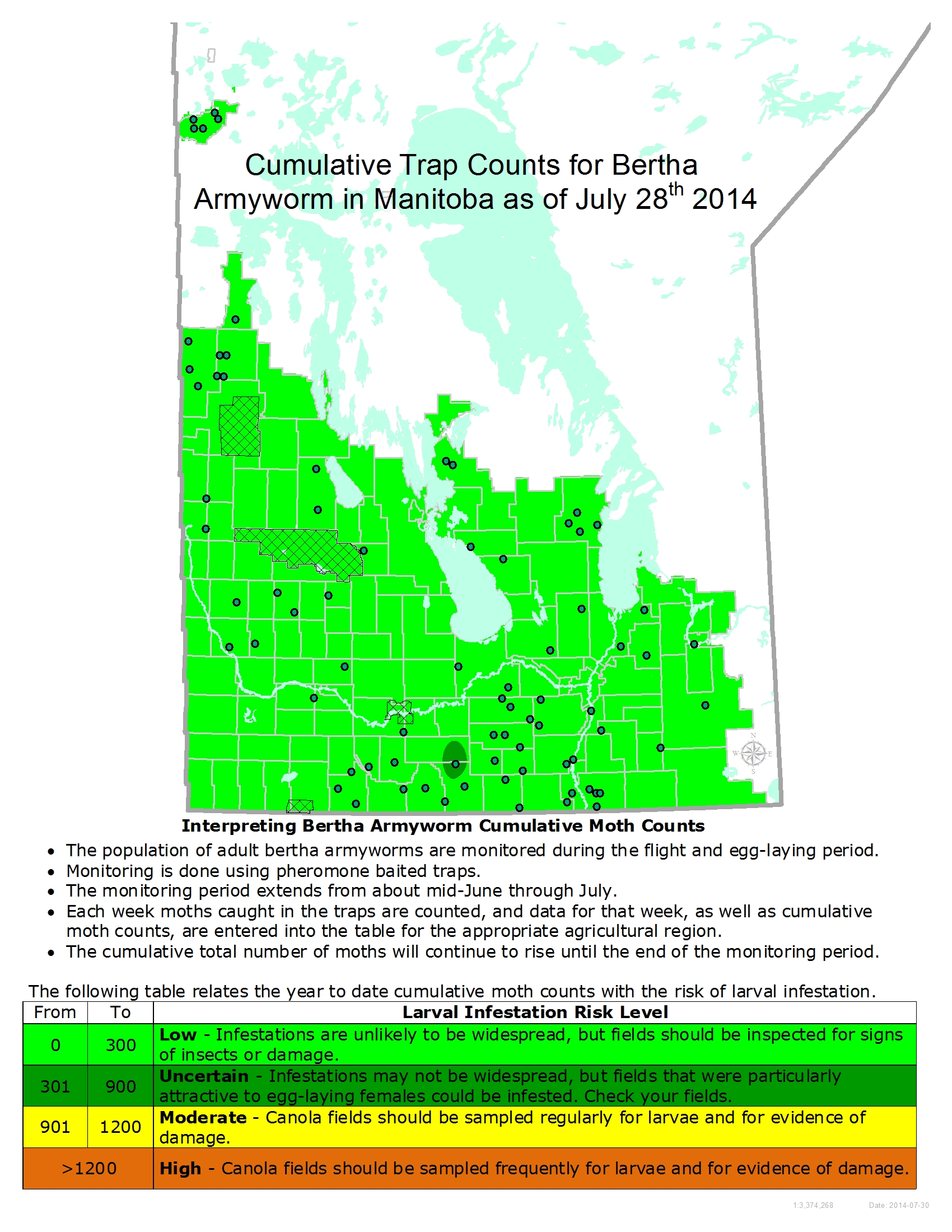Manitoba Insect & Disease Update: July 28 - August 1, 2014
Compiled by:
- John Gavloski, Entomologist
Manitoba Agriculture, Food and Rural Development
Phone: (204) 745-5668
Fax: (204) 745-5690. - Vikram Bisht, Plant Pathologist
Manitoba Agriculture, Food and Rural Development
Phone: (204) 745-0260
Fax: (204) 745-5690
To report observations on insects or plant pathogens that may be of interest or importance to farmers and agronomists in Manitoba, please send messages to the above contact address.
To be placed on an E-mail list so you will be notified immediately when new Manitoba Insect and Disease Updates are posted, please contact John Gavloski at the address or numbers listed above.
To be placed on an E-mail list so you will be notified immediately when new Manitoba Insect and Disease Updates are posted, please contact John Gavloski at the address or numbers listed above.
Summary
Pathology: Fusarium head blight risk for wheat is moderate to low in different areas of Manitoba. Most of the wheat crops have finished flowering and thus at low risk. By end of the month, Fusarium head blight risk maps may not be needed.
Entomology: Grasshoppers continue to be a concern in some fields. Canola growers should be checking canola for Lygus bugs. Lygus can potentially be of concern when they feed on the pods of canola if levels are high, although feeding to flowering crops is not likely to be economical as canola has a very good ability to compensate for damage to flowers, especially when soil moisture is good. So far Lygus levels appear to be below economic levels in canola, with a few exceptions in the Eastern part of Manitoba,
Corn
Goss's Wilt: Scouting for Goss’s wilt and leaf blight disease will help growers understand the status in their crop. Plowing under of infected crop residue can help reduce the inoculum for the next season. Spring surface runoff from corn fields has been seen to carry lot of corn residue over long distances to other fields. Rains accompanied with strong winds can also carry the bacteria in the mist over long distances. These 2 factors may be the reason that fields with good rotations and even no corn history may also show the disease.
European Corn Borer: Some egg masses of European corn borer have been seen in some corn fields in Central and Eastern Manitoba, although in many fields they are not at high levels. Now is the time to scout corn to see what the prevalence of corn borer is. Look on the underside of the corn leaves near the midrib for the eggs of European corn borer. In the photo below, the eggs in the upper-right are younger with little development having occurred. The eggs on the bottom-left are older and close to larval emergence. When you see black dots on the eggs, they are getting close to hatch.
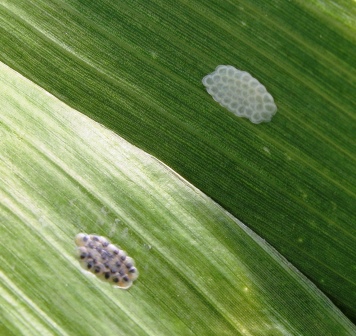
Wheat
Fusarium: The Fusarium head blight risk forecast for the whole province has been generally low to moderate in the province. Most areas report that the flowering in wheat crops is finished; and this reduces the risk of Fusarium head blight. Because wheat is at the end of flowering, the Fusarium head blight risk maps will be published only to the end of July.
In some areas, ergot on wheat and other cereals is showing up.
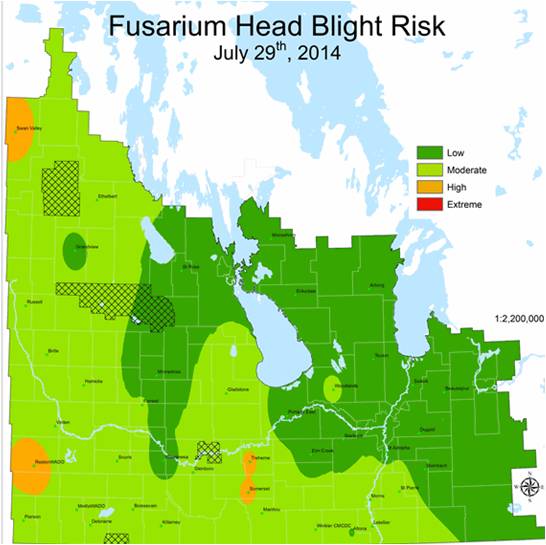
The Fusarium Head Blight Risk Forecast webpage is available at http://www.gov.mb.ca/agriculture/crops/fhb/index.html.
Wheat Midge: A reminder that once the wheat crop has flowered, it is no longer susceptible to feeding by wheat midge. There have been no reports of high levels of wheat midge in Manitoba yet this year; populations seem to be remaining at reduced levels. The emergence map (below) shows that greater than 90% of wheat midge should now be emerged in the southern part of Manitoba.
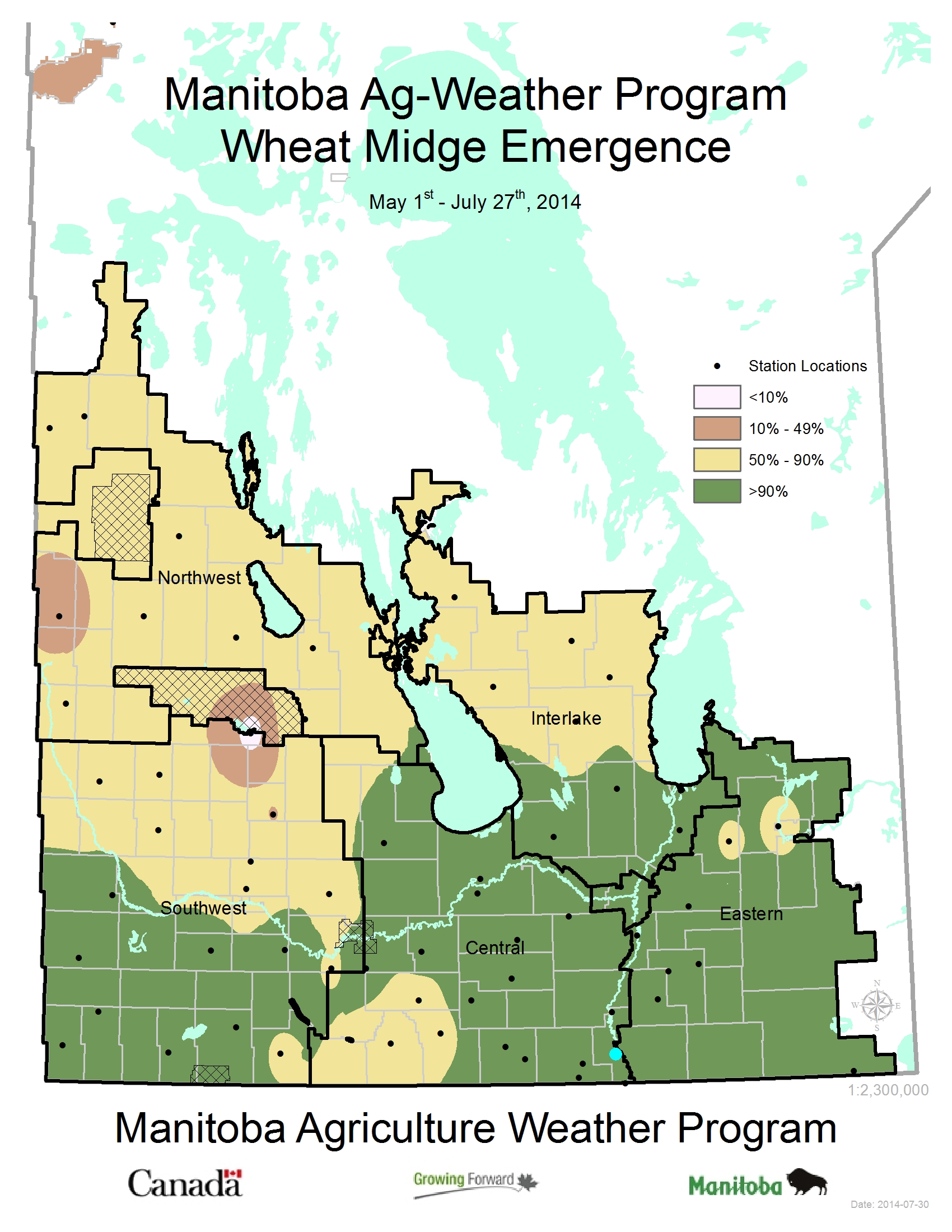
Grasshoppers in cereal crops: Grasshoppers will feed on all types of cereal crops, but do seem to have preferences. Research in Saskatchewan found that damage to oats was less than durum and
wheat, while feeding was most extensive to barley.
We are currently seeing both nymphs and adults present. The population seems to be mainly a mixture of twostriped and migratory grasshoppers. As a general guideline, about 8-14 adult grasshoppers per m2 is considered as a potentially threatening population in cereals. When scouting grasshoppers don't get too caught up on trying to do exact counts, this can't be done for insects that are jumping around as you move towards the area of your count, especially in dense crops where it can be hard to see to begin with. Try to get a feel for the range of grasshoppers you are seeing; is it just a few, such as 0-5, per m2, is it likely in the 8-14 / m2 range, is it greater than this. There is no way you can be too exact. It is not like counting an insect that remains rather motionless on the plants or ground. Also consider how much feeding they may be doing to the crop before making control decisions.
Below is a photo taken of a grasshopper caught in an alfalfa field near Elm Creek this week. Note the red specks clustered on the back. These are all red velvet mites, a parasite of grasshoppers.
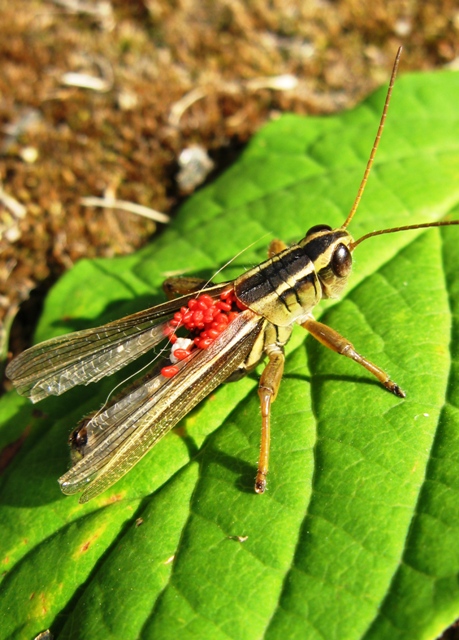
Canola
Counts remain relatively low in the traps for moths of bertha armyworm. Below is the risk map for bertha armyworm as of July 28th. The only trap count that has move from the low risk to uncertain risk category is from a trap near Altamont.
